“Test what you code before it goes live” has become phenomenal and imperative to save business reputation and retain users in the long run. After all, ignoring or overlooking software testing can take a big toll on your business.
Successful companies have always invested a good amount of resources in software testing to deliver a flawless user experience. For instance, SoundCloud has improved the testing infrastructure and created a well-balanced test pyramid in order to solve challenges like test flakiness and pipeline waiting times. It saved them resources in terms of time, money, and reputation.
It’s a no-brainer that world-class development teams follow a well-established testing cycle to avoid possible software problems. However, when it comes to quality assurance, no one size fits all. That is why, choosing the right software testing technique and approach for your product and development team is critical.
Usually, several types of testing are performed during the software development cycle, but the two prominent ones are functional testing and integration. Yet, both of these are often confused with other testing methods like system testing, performance testing, and security testing due to misleading definitions for each on several developer forums.
But, the significant difference between functional and integration testing lies in when, why, and how they performed. Our objective with this blog is to elaborate functional testing vs integration testing with some use case scenarios and clear the air.
Let’s explore them in detail.
What’s the Difference?
Despite the similarities between Functional testing and integration testing, there are some striking differences between the two. Functional testing tests the software against functional requirements while integration testing is performed to test the integration between modules. Here is a comparison chart that will help you understand the key differences between the both.
|
Criteria |
Functional Testing |
Integration Testing |
|
Purpose |
Testing the functionality as per user requirement |
Testing integration of individual modules combined as a component |
|
Order of Testing |
Conducted before non-functional testing |
Conducted after unit testing and before system testing |
|
Ease of Execution |
More complex than integration test |
Less complex to execute compared to functional testing |
|
Techniques |
Black box testing |
White Box, Black Box, and Grey Box Testing |
|
Issues Covered |
Issues that stop applications to perform their functionality |
Issues that occur while integrating different modules |
|
Results |
Not all issues get fixed or identified |
Chances of fixing issues are better than functional testing |
|
Maintenance Cost |
Highly expensive |
Expensive and high maintenance |
|
Scope |
Testing is based on user requirement |
Testing is based on interface requirement |
|
Tools Used |
Selenium, UFT, TestComplete |
Selenium, JUnit, Tessy, Jasmine |
|
Teams Involved |
Tester |
Testers and Developers |
What is Functional Testing?
Functional testing is a black-box testing technique that checks whether the software functions correctly in real-life situations. It compares the actual test results with the expected outcomes outlined in the software requirements specification (SRS) document. QA testers, test engineers, or business users carry out this testing practice. It includes regression, smoke, and integration testing.
Experts Insight: A major benefit of functional testing is that it tests an entire set of possible errors that is not addressed by unit testing.
Let’s consider an eCommerce application where a user makes a transaction. After developing the feature, developers pass the build to the QA team for testing. QA team studies the build and designs desired tests cases to check as follows:
- Is the transaction history stored correctly in the database?
- Is the transaction detail displaying promptly on the user’s screen?
- Is there anything that hinders or aborts the transaction midway?
Each build includes a wide range of test cases. The questions mentioned above are merely a few samples. Functional testing ensures the accuracy of steps involved in testing a specific build for possible failure or errors and makes sure that it functions properly.
What is Integration Testing?
Integration testing is a testing practice that evaluates how well system components work together. It involves integrating modules and testing the system for functionality, reliability, and performance. Independent testers or developers can perform integration testing after unit testing of individual modules.
Let’s consider a web application, which has two modules – a login page and a home page. After integrating the modules, testers are required to discover the defects in the interaction between the modules. Here, integration testing will check for these:
- How is the login page linked to the home page?
- Is the user able to see the welcome message after signing in to the web app?
- Will the user be navigated to the welcome page or home page after logging in?
In integration testing, you check for performance, data flow, and any changes that take place in the database.
Here is an illustration, where Kent C. Dodds portrays the importance of integration testing in one of his tweets.
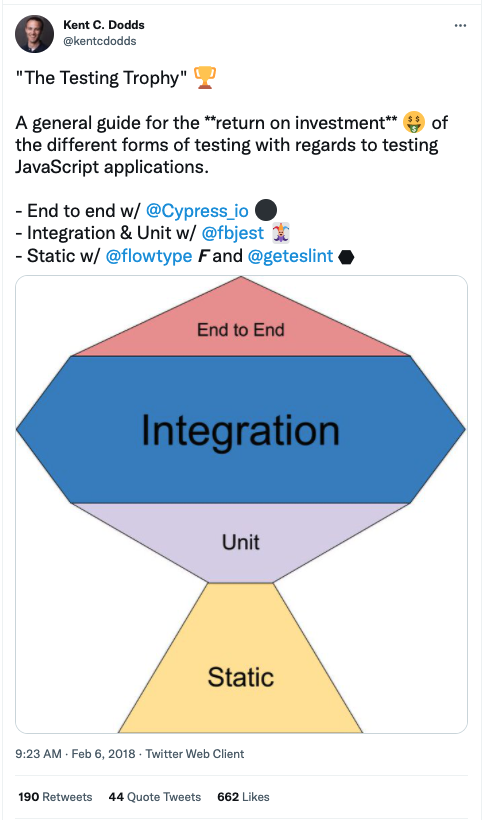
Purpose – Functional Testing vs Integration Testing
Why are these testing types an integral part of the software testing lifecycle? Let’s throw some light on their purposes that make both the testing types different from each other.
Purpose of Functional Testing
This testing aims to check the functionality of the user interface, end-to-end workflows, database, APIs, security, client/server communication, etc. Each functionality is tested by providing specific inputs to check the application’s expected behavior. The test result is then compared with the expected output to ensure software quality.
Purpose of Integration Testing
The primary purpose of integration testing is to check the functionality and performance of a system when different individual modules are integrated. It verifies the performance of multiple modules after integration. It is conducted by a specific test team who focuses on the application interface and data flow between the modules instead of overall functionality. Usually, this testing is initiated after unit testing.
Pros & Cons – Functional Testing vs Integration Testing
Pros of Functional Testing:
- User satisfaction: Ensures end-users witness satisfactory software performance at the least.
- No defect assurance: This testing streamlines all the software functionalities by detecting and eradicating bugs that occur during the test.
- Ensures security: Functionality testing looks after the security aspect of the software and makes sure that critical loopholes are encountered or avoided.
- Simulate actual user’s usage: Functional tests are conducted based on the usage rather than creating assumptions about the structure of the system to perform the test.
- Risk-free tests: It reduces the risk and loss involved in the software by evaluating the critical functionalities and features first.
- Test Case Customization: This testing provides possibilities to create different types of functionality-based test cases to suit different requirements.
Cons of Functional Testing:
- Logical errors: Chances of logical interlinking between the codes, libraries, and so on could be missed easily.
- Expensive: This testing requires some test cases to be repeated resulting in redundancy that eventually could increase the testing cost.
- Complexity: One small change in a function may affect the entire application if the features are tightly coupled, making the testing conditions complex in nature.
- Time-consuming: Functional performance can be evaluated by designing context-specific tests that consume good time.
- No deployment guarantee: It does not guarantee if the product is completely bug-free and is ready to go live.
Pros of Integration Testing
- Testing flexibility: Testers can start integration testing whenever any relevant module is available rather than waiting for all the modules to be put together for testing.
- Less Risky: Reduces the software failure risk by eliminating the overall number of bugs and decreasing the negative influence caused by changes in the code.
- Detects issues easily: Detects problems that were ignored at the time of unit testing, that are related to interfaces, data formatting, and third-party services.
- Stimulates interaction: It validates the functional and non-functional behavior of the integrated modules and third-party APIs.
- Maximum Test Coverage: Integration testing has a wide scope as it can test multiple modules that enhance the reliability of the results.
Cons of Integration Testing
- Faults in Software: Testing time is longer, and test cases that are not covered in may pave possibilities for errors and malfunctions to be overlooked within the software.
- Testing process failure: Any error or mistake made in the testing strategy could turn the whole testing process into a disaster.
- Time-consuming: Defects in integration testing are difficult to fix and take a huge amount of time.
- Dependency on Stubs & Drivers: Creating stubs and drivers correctly is mandatory to perform this testing. If not, then it may result in inadequate testing.
Challenges of Functional Testing vs Integration Testing
The entire software application testing process involves several steps, from requirement gathering to designing and executing test cases that analyze the entire application for defects. In the process, there are many unforeseen challenges that may arise too. To avoid irreversible consequences, let’s have a look at the risks you may face while performing functional and integration tests:
Challenges of Functional Testing
- It’s cumbersome to define test requirements clearly for every change made because of the detailed and measurable information test requirements contain.
- Maintaining a simplified report to identify go/no go decisions with the functional tests may not be entirely possible as this test splits reporting in terms of features-based and defects-based.
- Difficult to overcome the mismatch between the required functionality and the test plan while conducting the test.
- Hefty amount of time taken for resolving recurring issues and setting up the test environment.
- Replanning the initial test strategy for different functions may cause confusion.
- Creation of test metrics to scrutinize and improve an application is not entirely possible due to software complexities and variation in test requirements.
However, these challenges and risks can be resolved by adopting some best practices and strategies.
Challenges of Integration Testing
- When replacing mocked data with real modules, new bugs can be discovered.
- Takes time and requires good programming knowledge to write integration tests because programs and data needed for testing are mocked.
- Difficult to understand the logic because the software code is written by multiple teams separately.
- It is complicated to perform tests on integrated modules because diverse factors like database, platform, and software environment influence the testing process.
- Following various testing approaches and combinations increases the difficulty of selecting the appropriate one for testing.
- Integration testing becomes more complex when externally integrated features, tools, and libraries influence the application as well as they are built by different companies with different dependencies.
When to Perform Functional Testing?
Functional testing is pivotal to be performed on complex business softwares. It is advantageous for applications that have completed formal internal testing and before regression testing. It is usually done when you want to fix bugs or implement new features. Furthermore, this testing is good to be performed at each level of the verification and validation model, from unit testing to user acceptance testing or beta testing.
Let’s shed some light on a few use case scenarios:
Situation 1:
Every web application has a login page consisting of three elements – Username, Password, and Login/Sign in button. Following will be the test cases for checking the login functionality of an app:
- Is the user able to log in after entering a valid username and password?
- Does any ‘forgot password’ link exist for the users?
- Will a particular error message display while entering invalid input?
Situation 2:
Consider you want to test the upload photo feature in a social networking app. For this, the functional test cases should be:
- Is the photo getting saved in the storage library after users upload it?
- Are users able to add tags while clicking on the Tag button?
When to Perform Integration Testing?
Integration testing is crucial when software is exposed to frequently changing requirements. This testing proves effective when those changing units are combined. Moreover, some modules that interact with APIs need to be tested to ensure that the data accepted by an API and the response generated are related with each other. Apart from this, it’s the best technique for complex software testing. It lets you determine whether the software developed by different teams is working as per the intended goal or not.
Let’s look at some use case scenarios:
Situation 1:
Suppose you are developing a payroll application, which has three units – employee login, employee report, and employee salary information page. The flow for this condition should be:
| Employee Login-> Employee report-> Employee Salary Information |
The following may be the test cases to rectify the flow and sequence of activities:
- Is the employee directed to the report page after successful login?
- Is the employee directed to the salary information web page instead of the report page after login?
Situation 2:
Let’s take a technical example of an email service. Flow for this email service application would be:
| Login-> Inbox->Send / Delete Mail-> Logout |
After entering valid credentials, the login page directs us to the inbox page. Here, integration testing is performed, and the following could be the test cases:
- Are users directed to the inbox page after logging valid credentials or some junk folder or trash folder?
- Are emails moving to the trash/sent folder after deleting/sending emails?
Process – Functional vs Integration Testing
Process of Functional Testing
Functional testing also improves the communication between developers and testers. It is simple to be handled by analysts familiar with the testing techniques and tools. However, there is a process that is involved. Let’s have a look:
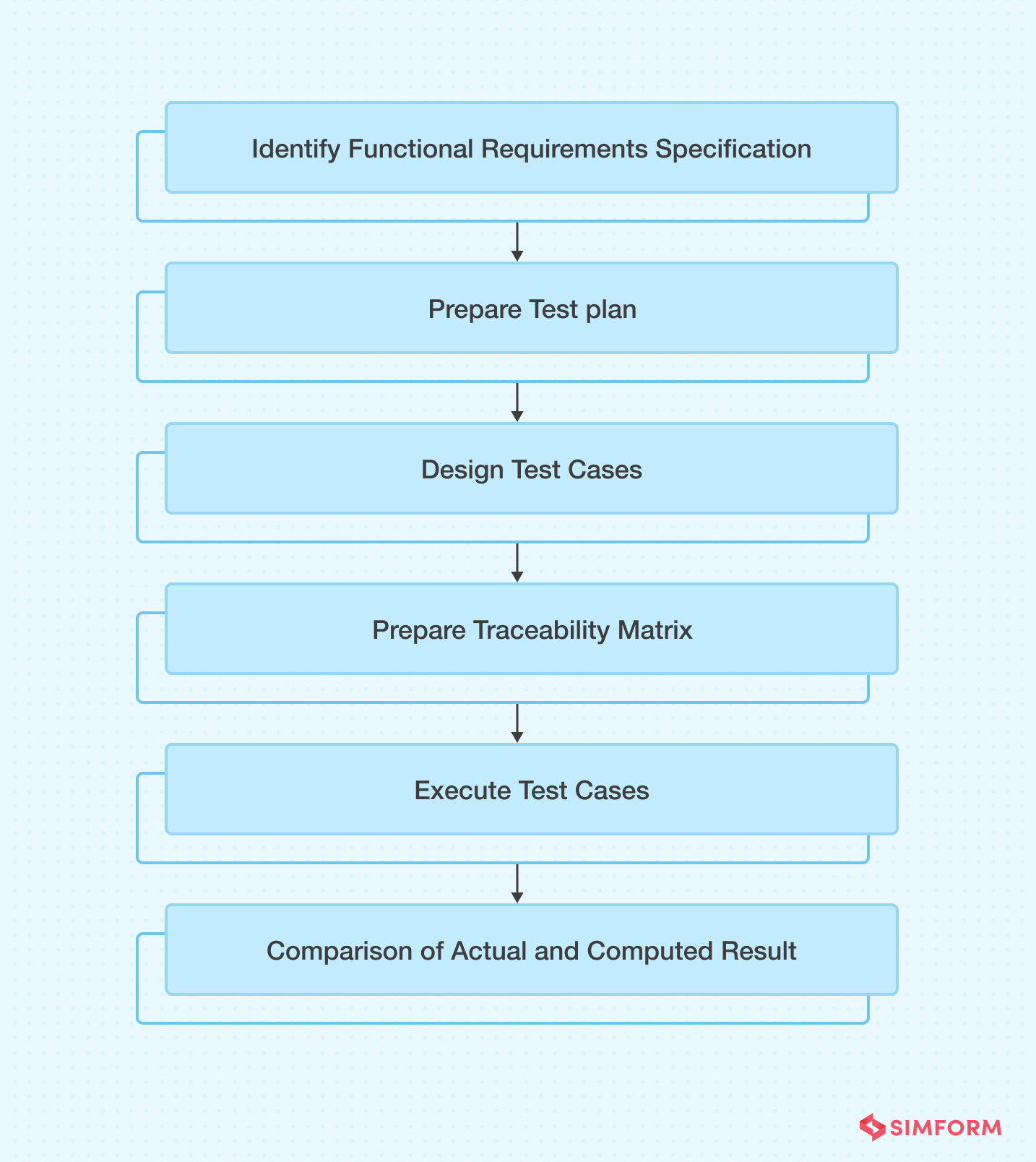
- First off, the tester understands and verifies the requirements specification and then prepares a test plan.
- Post analysis and planning, testers design test cases, and then a document is prepared for the traceability matrix.
- Testers create input data as per the requirement and execute test cases.
- Compare actual results with the expected output to validate if the functions are working as intended or not.
Test a small set of functions at a time to reduce the chances of system failure, especially when you are checking some complex functionality or the interface of your application.
Process of Integration Testing
First and foremost, integration testing is intended to check for issues within the combined modules, which are initially unit tested. Then, you are supposed to combine those unit-tested modules into a component to perform integration testing. Following are the steps to get started with this testing phase:
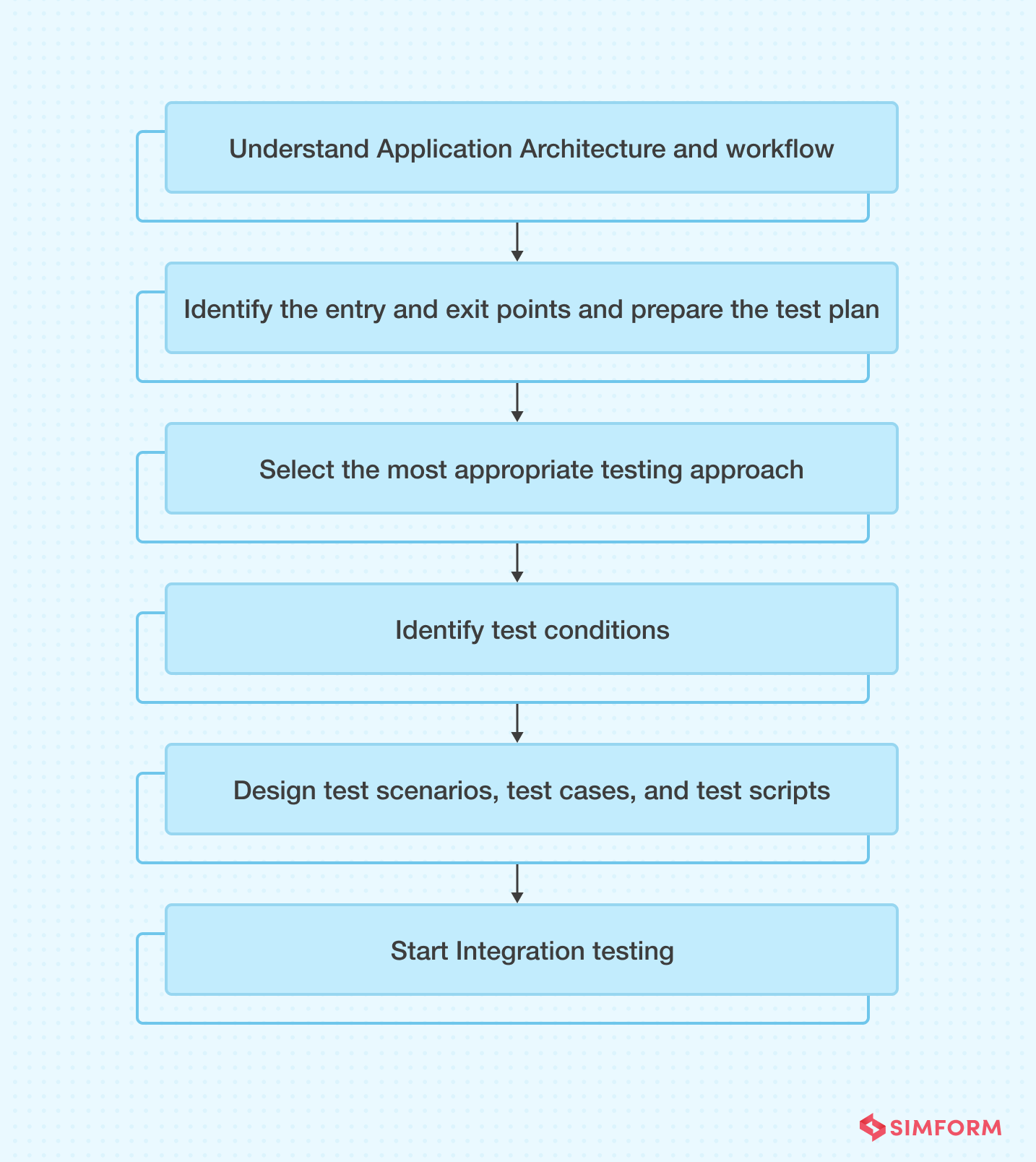
- First, understand the application architecture and workflow of different modules of an application.
- Get an overview of each module’s functionality, identify the entry, exit points and prepare the plan for the integration test.
- Select the most appropriate testing approach and identify test conditions according to the data flow.
- Design test scenarios, test cases, and test scripts and perform integration testing after deploying chosen modules.
Following this process, you can efficiently track the bugs and defects associated with the data flow of an application. The test results can also be recorded for further analysis and to fix the flaws.
Techniques & Approach – Functional Testing vs Integration Testing
What techniques and approaches are carried out in Functional Testing?
Functional testing is a black-box testing technique where the software’s functionality is tested without looking at the internal code or internal structure. However, there are two more ways this can be carried out. The testing could either be requirement-based and business-process-based. You can opt for requirement-based testing to evaluate software’s essential and complex functionality. On the other hand, business process-based testing is the best option if the knowledge of business requirements and scenarios is crucial to perform some specific or customized functional tests.
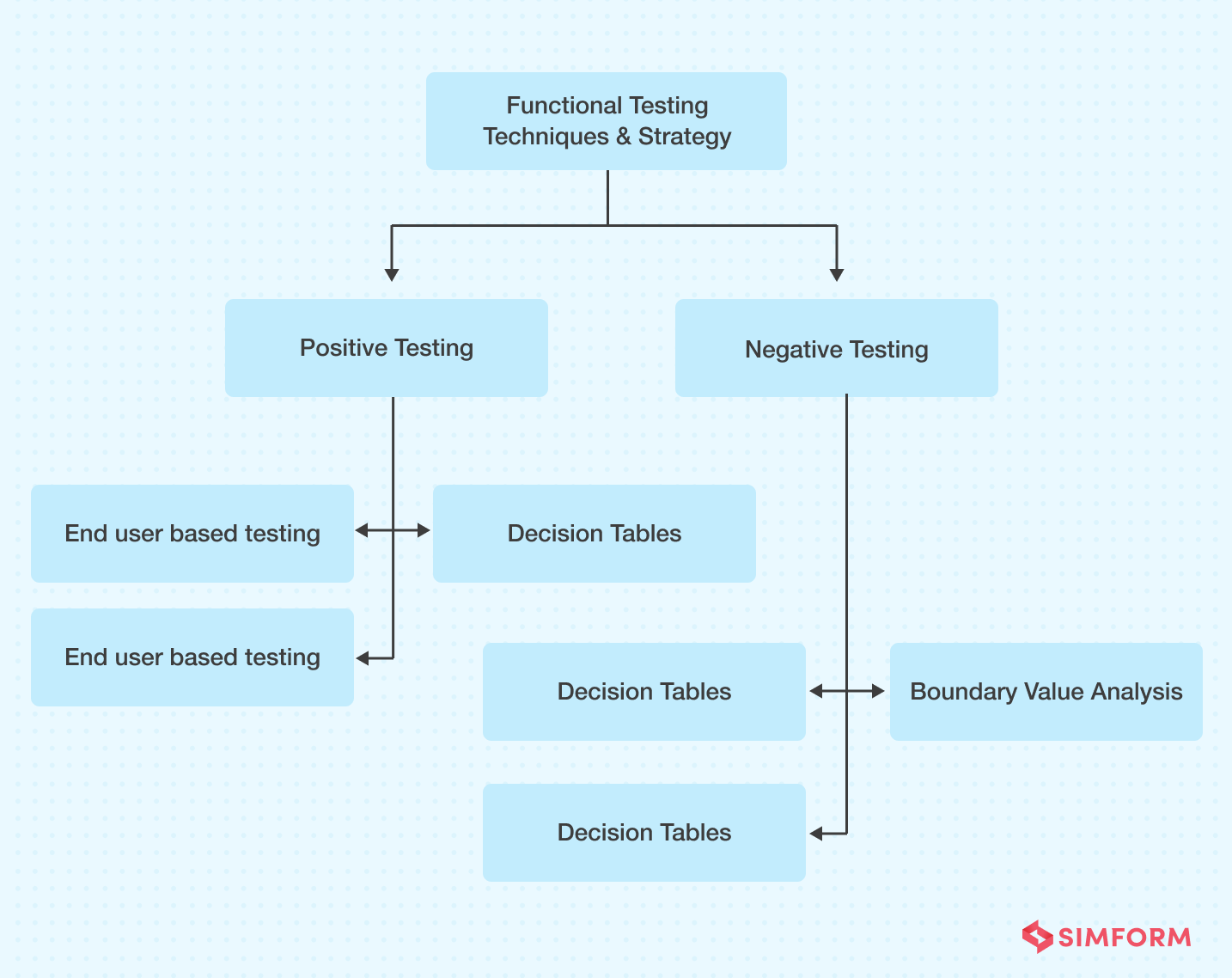
Apart from the techniques mentioned above, you have few more approaches to conduct a functional test, which includes:
- Positive Testing: It ensures that the software meets users’ basic requirements and behaves as expected. This testing approach is classified into end-user-based, decision-based, and alternate path testing.
- Negative Testing: It ensures that the software is working seamlessly, even if it counters unexpected or continuous changes in the source code. It is categorized in equivalence, boundary value, and ad-hoc testing techniques.
QAs are supposed to carry the most appropriate technique as per the requirement that improves the test performance and software quality.
What techniques and approaches are carried out in Integration Testing?
You can opt for white box testing, black-box testing, and grey-box testing methods to perform integration testing. In addition to that, these four testing approaches can be categorized broadly into two groups – Incremental software integration and Non-Incremental software integration. Following are some of the testing approaches:
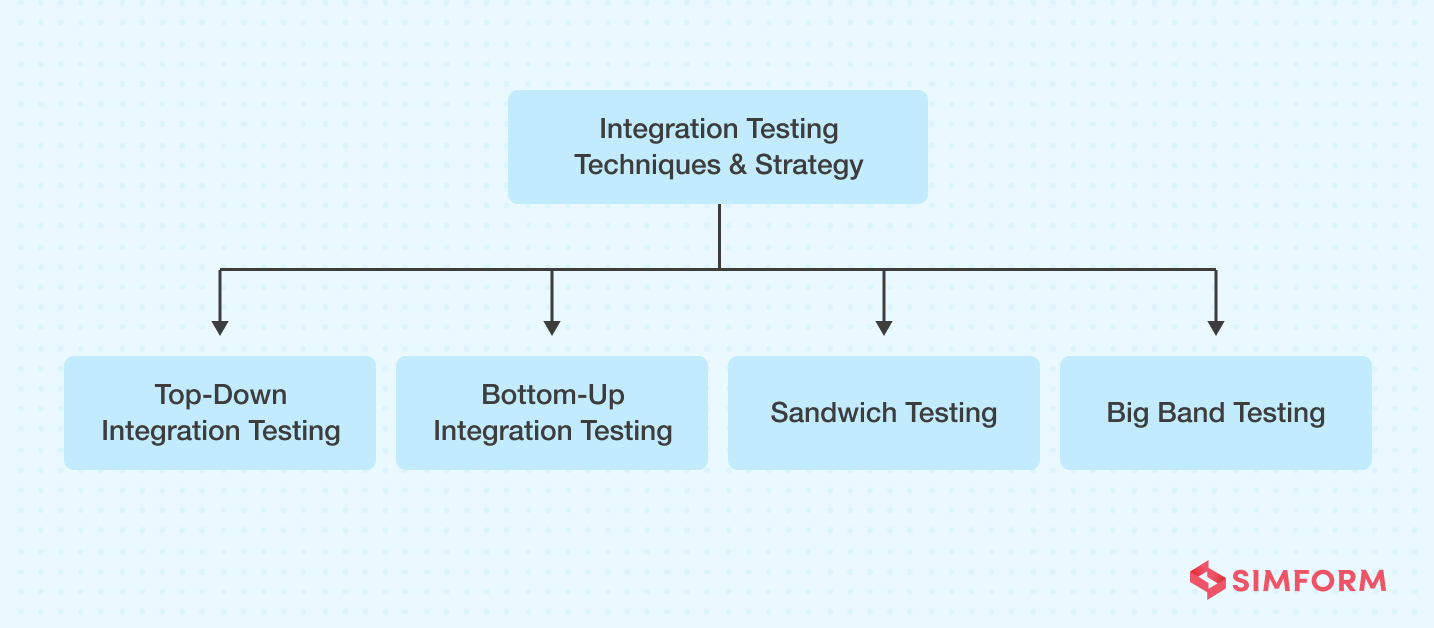
- Top-down Approach: It lets you test high-level logic and data flow at first to minimize the need for drivers (dummy module created for test purposes).
- Bottom-up Approach: Low-level utility modules are tested and integrated first in this approach to minimize the need for stubs (dummy module created for test purpose).
- Sandwich Testing Approach: Also known as Hybrid integration testing, where bottom-up and top-down approaches are conducted parallelly. It is used primarily on large projects with several sub-projects.
- Big Band Approach: It is the best approach for small-sized applications, which lets you perform integration testing on all modules in one go.
Functional Testing Tools
Tools are a crucial part of automating functional testing as it helps you execute tests quickly and efficiently. There are many tools that are extremely useful in minimizing the work effort. Here, we have listed a few tools that you can use to perform functional testing.
- Selenium: An open-sourced automated test suite for web applications that uses domain-specific language Selenese to write tests.
- UFT(Unified Functional Testing ): A commercial testing tool for API, web services, and GUI testing of desktop, web, and mobile applications across platforms.
- TestComplete: A commercial testing tool to perform keyword-driven and data-driven testing. It supports various scripting languages like JavaScript, Python, etc.
- Micro Focus LeanFT: A powerful test automation tool for engineers, developers, and testers in Agile teams to handle complex algorithms.
The list does not end here. Watir, Katalon Studio, Ranorex, SoapUI, and many more are also available that you can use for functional testing.
Integration Testing Tools
Integration tests can be run manually or automatically. You can find a plethora of tools to automate the integration tests. We have listed a few most popular tools that can improve the efficiency of your test cases:
- Selenium: A popular open-source tool for integration testing that supports multiple programming languages and is compatible with various environments.
- JUnit: A framework to perform high-quality integration tests, widely used in test-driven development process and it supports Java.
- Tessy: A tool consisting of Workspace, Test Data Editor (TDE), and Test Interface Editor to perform integration testing for embedded softwares.
- Jasmine: A behavioral-driven development (BDD) tool for web applications that supports JavaScript and runs on multiple browsers.
If these do not meet your expectations. There are more tools like Protractor, Citrus, FitNesse, etc., to automate the integration testing process.
Conclusion
Functional testing and integration testing are essential to delivering high-quality products to end-users. However, both share the same objectives, like detecting defects in the software to ensure quality, but they serve different purposes. Both have their own advantages, limitations, challenges, and approaches to discover flaws.
Here, you have learned about the differences between functional testing and integration testing. After all, it’s vital for developers and test engineers to differentiate these two testing types. Furthermore, stakeholders are also advised to ensure that these testing types are performed in the correct order before deploying the application into the market.
If you are still at a crossroad trying to figure out how to conduct these tests, drop us a message or contact us anytime.